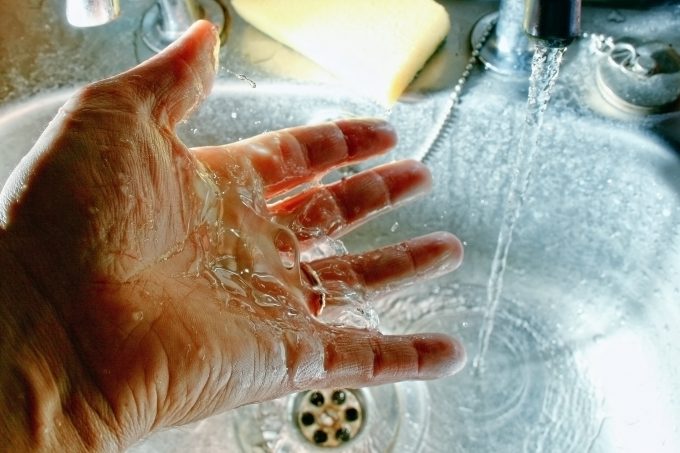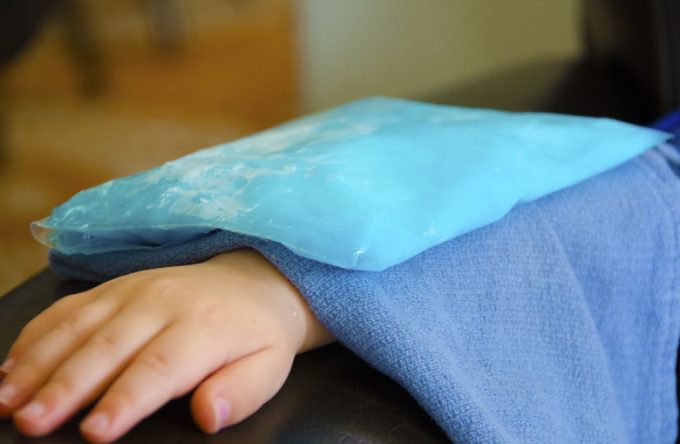How to Get Rid of Poison Ivy: Effective at Home Cures Anyone Can Use
Poison ivy is one of the most obnoxious plants you can stumble upon in the wild because it contains high amounts of urushiol. This substance is responsible for the countless irritations and swellings people get when getting into contact with it.
See also: How Long Until Poison Ivy Rash Appears: How to Recognize Symptoms and Treat Rash
So it’s important to know how to get rid of poison ivy and of its toxic effects, particularly if you’re outdoors and don’t have immediate access to your medicine cabinet. But in this article, we’ll also tackle some home solutions to improve your irritation, so read on.
Your first steps
The first things you do after touching the leaves of this poisonous plant are really the most important since they influence how fast you’ll get better.
Wash up
Your number one concern is to get clean as fast as possible. If you’re interested how to treat poison ivy effectively, getting urushiol out of your system fast is the essence of it all.

Some websites recommend washing the spot in two hours maximum, but we say don’t risk it. 20 minutes tops are enough for urushiol to penetrate your skin and trigger an allergic reaction.
Key things to remember
- Use plenty of water. Running water that is, because you want to eliminate the traces of urushiol from your skin.
- If you’re outside, head towards the nearest available water source if you don’t have plenty to us in your backpack.
- When you’re cleaning the area, be careful not to touch it too much with your hands. Using some disposable gloves for this process is highly recommended.
- For the same reason, you shouldn’t jump into the shower to get clean thinking you’re going to be killing two birds with one stone. Instead, just wash topically, to lower the risk of spreading urushiol on your body.
- If you have a choice between cold or hot water, try to use icy-cold. The reason is that cold water doesn’t open the skin pores, so the poison can’t get into the bloodstream as fast.
- The more urushiol gets beneath your epidermis, the bigger allergic reaction you’ll get. So it’s key to rub it out not just with your hands, but using a loofa or a clean cloth.
- If you’re outdoors, sacrifice a T-shirt to make sure you can scrub everything out.
- Sand is a good means of scrubbing, so if you accidentally get poisoned when you’re at the seaside, it’s even better to use sand than a loofa.
- Plus, if you have access to salt water, remember that salt closes the pores even more. And it’s also a disinfectant, so all the more reason to use sea water for instance.
- Don’t forget washing all your clothes and pieces of equipment that might have gotten into contact with poison ivy. Since urushiol has a pretty long lifespan, you can actually get the irritation hours or days after contact, by touching one of these items.
- When you’re washing these clothes, be careful not to mix, touch or put them into the washing machine with other clothes that haven’t come into contact with urushiol.
Dish detergent vs. soap
There are two contradictory opinions when it comes to using dish detergent or regular soap to clean your skin. Either way, plain water won’t do the trick on its own, so you’ll definitely need some kind of soap to prevent urushiol from spreading.

Dish soap
- Urushiol is an oil, so it’s better dissolved in a dish detergent.
- You should limit the rash better if you get a product that specifically states it removes oils proficiently.
- If you’re outdoors in a less extensive hike or camping trip, you may not have something like this with you.
Regular soap
- Some soaps can dissolve oils as well as dish soaps do.
- Using a soap that’s not that particularly creamy is better because it won’t get mixed up with urushiol, nor get it into your skin. So choose a soap that leaves that “squeaky clean” feeling after washing up.
- The advantage is that if you’re outdoors or away from home, there are more chances you have access to regular soap than dishwashing soap.
Some people swear that scrubbing the area thoroughly is more important than what you’re doing it with. So ultimately the choice between these two soaps depends on what you have on hand because they both get the job done.
Get some alcohol
Medicinal alcohol is a good tool to help you treat poison ivy rashes faster if you carefully dab it onto the affected area. Of course, this should only be your second step, after you’ve cleaned the spot with water and soap, and rinsed thoroughly.

Key things to remember
- Only use alcohol when the skin is clean.
- Urushiol is an oily substance, so alcohol may remove it better.
- Dab some alcohol on the affected area as soon as possible, immediately if you have some in your First Aid Kit.
- Do this by pouring some alcohol on a bit of wadding, a clean cloth or a cotton pad.
- Remember not to rub the spot, but dab it gently. The reason is that rubbing can get more urushiol in your blood if traces of it are left on your skin.
- Alcohol is used to prevent and even stop the spread of other rashes, so it can work to stop poison ivy irritations too.
Ice, ice baby
Once these first two steps are done, you can think of additional measures how to treat poison ivy. One of these miracle workers is ice because it acts much the same way as cold water in closing the pores and preventing urushiol absorption in your blood.

Key things to remember
- Use an ice pack or a cold compress, but never apply ice directly on your skin. Your purpose is to constrict your blood vessels and pores, not inflict more damage to your skin.
- Do this as fast as possible to prevent urushiol from spreading.
- You can also do this when you’ve already gotten a poison ivy infection, to decrease the redness, swelling and possible blisters.
Homemade cures
When it comes to poison ivy home remedies, you have a wide array of options. And sometimes, it’s pretty interesting how nature works, placing the cure exactly near the toxin. So actually our first trick is more of a wilderness remedy, not a home remedy.
Jewelweed
The first thing you can start with to treat poison ivy is something that’s actually found near it in the wild.

Look around the perpetrator, and you’ll probably see a bush that grows close to the ground, with lots of leaves and flowers which look like little yellow bells. To use it, simply:
- Gather some of its leaves.
- Crush them as well as you can, to make a paste.
- Use this paste topically, on the skin area that got into contact with poison ivy.
- Leave it there until it gets dried up, so you’re sure it sucked as much as possible from the remaining urushiol.
- Wash it with lukewarm water.
- Repeat the process as often as you can throughout the day.
Baking soda
Another great poison ivy home remedy is this magic powder for at least three reasons:
- It’s something most people have in their homes.
- It extracts the water from the cells, along with any trace of poison that might be left inside.
- It calms down the irritated skin thanks to its pH.

That’s why you can safely use baking soda before you’ve actually developed the allergic reaction, as well as in the late stages, once you have the nasty symptoms like rash, swelling, and redness. And the good news is that it’s fairly easy to use, by following these instructions:
- Make a paste out of it, by adding water.
- Make enough paste depending on how big your rash and/ or the area of contact is, by adding three parts water and one part baking soda.
- Spread the paste on your skin with tapping motions, not rubbing.
- Allow the paste to fully dry.
- Remove the paste by washing the area with cold water.
- Repeat three to four times per day, until your symptoms get better.
These instructions work for the both scenarios, before and after the actual rash. But once you do get the rash, you can also use baking soda like this:
- Prepare yourself a cool bath.
- Add a cup of baking soda.
- Soak in and relax, you’ll feel less itchy in no time.
Apple vinegar
Vinegar is a multipurpose ingredient you’ll find in your cupboard, and somewhat of a panacea for ailing different aches and pains. Since it’s such a good disinfectant, you can use it on most superficial wounds, scratches, and rashes.

Here’s how you do it:
If you have a larger affected area
- Mix one part apple vinegar with three parts water, depending on how big the irritated area is.
- Submerge that part of your skin under the water.
- Or: pour this mixture onto the problem zone.
- Let it air dry for a more soothing effect.
- If you don’t have the time to air dry it, dab the area gently with a clean cotton towel.
If you have a smaller affected area
- Mix one part apple vinegar with three parts water, depending on how big the irritated area is.
- Soak a clean cloth inside this mixture.
- Dab this cloth on your skin.
- Or: make a compress to last longer.
These two methods are great for calming an already developed irritation. However, since vinegar is such a good disinfectant, you can also follow these instructions before the rash takes place.
Coffee
We bet you didn’t know you can use this wondrous liquor for something else than your morning energy boost. But coffee has anti-inflammatory characteristics, thanks to its content rich in antioxidants.

In fact, caffeine works so well to reduce all kinds of swellings, that it has actually been added to various anti-inflammatory medicine, including aspirin and acetaminophen (Paracetamol). Plus, it’s been found that it takes away most of the mild to moderate pains so it will work as an analgesic for your poison ivy rash too.
Here’s how you do it:
- Brew one cup of coffee by adding 2-3 teaspoons of coffee to 8 ounces of water.
- Allow the coffee to cool down to room temperature.
- Place the cooled coffee in the refrigerator.
- Don’t put hot coffee straight in the refrigerator, it might lose some of its properties.
- Wash the affected skin with ice-cold coffee.
- Or: make a cold compress to calm the irritation.
- Repeat this several times each day, until you feel better.
Oatmeal
Oatmeal is definitely among the best poison ivy home remedies because it’s been long known to calm pain and reduce itchiness. Oatmeal has a neutral pH and when mixed with water it cools your skin. Plus, it also contributes to decreasing the swelling and redness and taking away some of the pain inflicted by the rash.

To use oatmeal effectively, follow these steps:
If you have a larger affected area
- Get one cup of oatmeal.
- Put it into the blender until it’s well ground.
- Draw yourself a nice warm bath.
- Add the cup of oatmeal inside the bath.
- Let the water cool as much as you like.
- Get inside the tub and relax for half an hour.
- Do this every day until you feel better.
If you have a smaller affected area
- Grind some oatmeal in the blender.
- Put one tablespoon of oatmeal in a glass of water and mix well.
- Wash the affected area.
- Let it air dry or dry it by tapping with a clean towel.
- Or: make a cold compress.
- Repeat this several times per day until it gets better.
You can use oatmeal effectively even if you cook it, like this:
- Cook some oatmeal, as you normally would, or maybe even a bit thicker.
- Let the oatmeal cool down a bit, until it’s no longer burning hot, but still warm.
- Apply the oatmeal paste on the affected area and let it cool, thus soothing your skin.
- Remove the paste by washing it with cold water.
- Repeat two-three times daily.

Tips:
- If you cook the oatmeal too thin, it won’t stick.
- If you put hot oatmeal on your skin, it will actually burn it, so don’t.
A cool trick to this recipe is to add a teaspoon of baking soda when cooking the oatmeal, for all the beneficial characteristics above.
Aloe vera
This plant is another panacea thanks to all its anti-inflammatory and analgesic properties. Basically, these are the substances found in the aloe vera gel and what they can do to help you:
- Vitamins: help the skin recover after a burn or irritation.
- Minerals: contribute to a soothing effect and reduce swelling.
- Antioxidants: decrease pain and reduce irritation.
- Aminoacids: minimize inflammation and help the skin recover.

There are different ways how you can use aloe vera like:
- Drawing the gel and applying it directly to the affected area a few times each day.
- Preparing a bath out of aloe vera leaves and water.
- Making cool compresses out of cool coffee and aloe vera.
Himalayan crystal salt
Since urushiol is what triggers the irritation of your skin, making it swell up with pus and red, you can effectively use salt. That’s because:
- It dries up the swollen skin cells.
- It sucks up the poison inside your skin cells, along with the pus.
- It has antianalgesia characteristics, minimizing any pain and itchiness you might feel.

This great home remedy against poison ivy can be used like this:
- Make a paste out of enough salt and a few teaspoons of water.
- Apply this mixture on your skin until you feel better.
- Allow it to dry.
- Remove it with cold water.
- Repeat this a few times each day until the symptoms disappear.
Or:
- Get one cup of salt.
- Fill the bathtub with lukewarm water.
- Put the salt into the tub.
- Relax for 30 minutes.
- Do this once per day.

But these are all things you can do after the irritation occurs. However, since salt has disinfectant properties as well as anti-inflammatory, you can use it to wash up first thing after getting into contact with the poison ivy. See more tips and guide on how to stay safe in your next camping trip.
Potential medicine you can use
If you’re less of a “plants can cure everything” sort of person, and trust the fast effects of modern medicine more, here’s what you can take:
- Antihistamines. These are basically allergy drugs, that stop the itching and the rash from spreading more. They work because the irritation caused by poison ivy is in itself your immune system’s response to its toxins, and thus an allergic reaction.
- Corticosteroid cream. This decreases the swelling and reduces the irritation fast if you apply it conscientiously several times per day.
- Calamine lotion. Even the FDA says it’s ok to use this for rashes, including poison ivy-related, as it will soothe the itchiness.
See our article that show you how to administer first aid in the wilds, a must-read for everyone.

All these are over the counter drugs you can easily purchase without a doctor’s note. However, if you’re allergic to some of them or aren’t particularly sure if they’re ok for you, it’s always wiser to consult a physician before using them.
For a more comprehensive information on poison ivy, see our earlier article on this topic.
What will it be?
That being said, we’re curious what you’ll choose to treat poison ivy rashes from now on. If you tried a home remedy that worked wonders, come back and let us know. Same goes if you’ve tried something that backfired. Plus, if you have other tips and tricks for our readers, we’d really like to know too, so leave us a comment below!





